Empowering Teens to Transition Successfully into Adulthood
Preparing adolescents with autism for adult independence involves a comprehensive approach to developing essential life skills. Early intervention, tailored teaching strategies, and structured support systems play pivotal roles in fostering confidence, self-reliance, and social integration. This article explores key categories of life skills, effective methods for skill development, assessment tools, and the resources available to guide parents, educators, and caregivers in supporting autistic teens on their journey to adulthood.
Key Categories of Life Skills for Transitioning to Adulthood
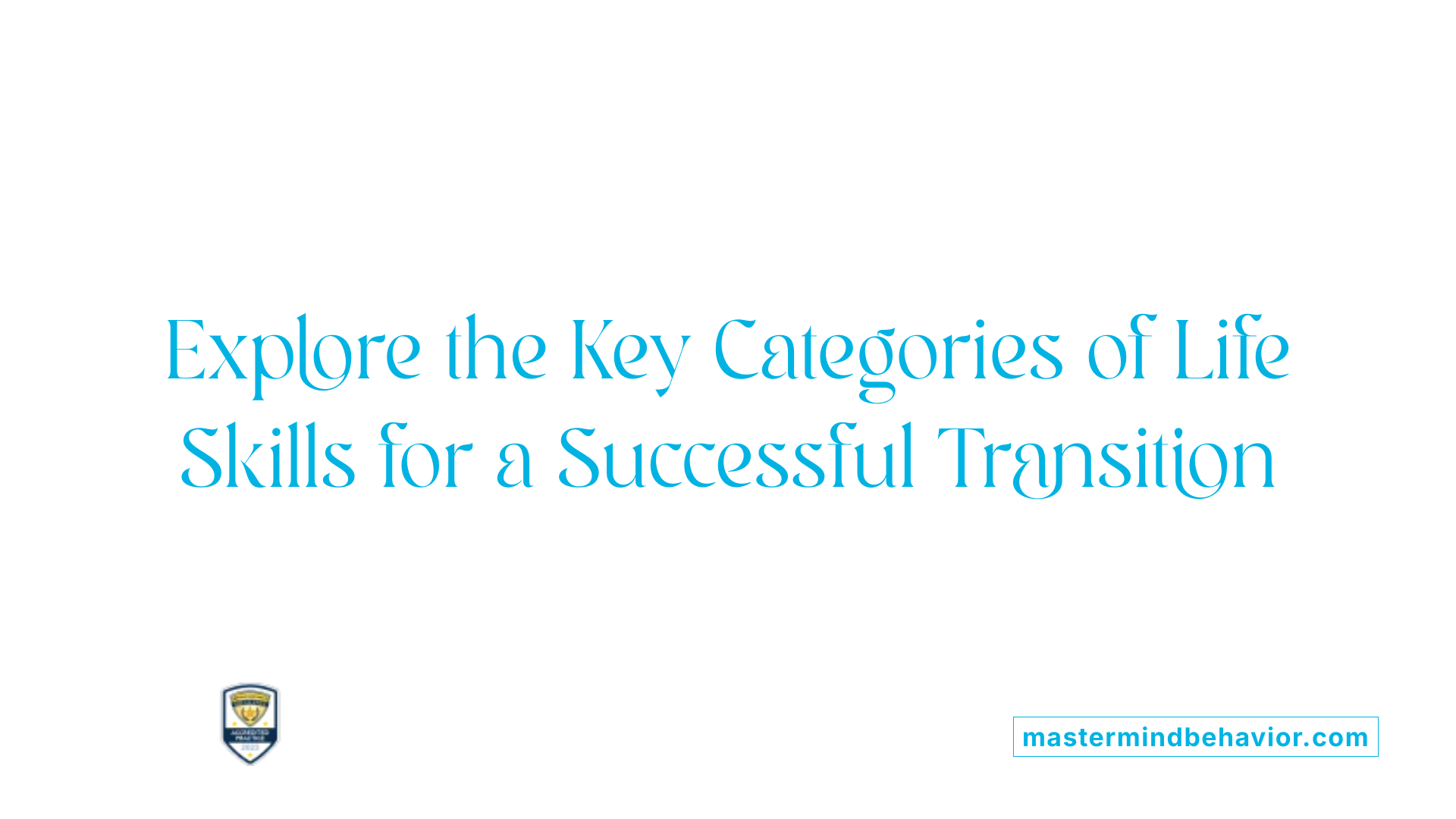
What are the key categories of life skills necessary for transition to adulthood for autistic teens?
Supporting autistic teens in their journey toward independence involves developing a broad set of life skills across various domains. These skills are essential for navigating the complexities of adult life, including personal, social, and practical aspects.
A primary focus is on social skills. Enhancing abilities like initiating conversations, understanding social cues, and building friendships helps teens integrate into their communities and maintain meaningful relationships. Role-playing, group activities, and social skills training are effective methods for fostering these abilities.
In addition to social skills, daily living skills form a cornerstone of independence. This category encompasses personal hygiene routines, cooking, cleaning, and managing household chores. Budgeting, money management—such as opening and tracking bank accounts, and understanding credit—also fall under this umbrella, equipping teens with financial literacy essentials.
Employment skills are equally vital. Preparing teens for the workforce involves teaching job readiness, including how to prepare resumes, practice interview skills, and understand workplace expectations. Internships and vocational training programs expose teens to real-world work environments, helping them build confidence and competence.
Housing independence is another critical area. Teens should learn skills related to maintaining a living space—like organizing their home environment, basic repairs, and understanding lease agreements. Supporting their exploration of housing options, whether supported living, group homes, or independent apartments, prepares them for adult living scenarios.
Self-advocacy and knowledge of legal rights empower teens to communicate their needs effectively and navigate adult legal and healthcare systems. These skills include understanding supported decision-making models versus guardianship, advocating for accommodations, and knowing how to access services.
Finally, health care management teaches teens to schedule appointments, maintain healthcare routines, and understand emergency procedures. Stress management and emotional regulation strategies support overall well-being.
Developing these skills requires early, personalized planning. Transition services, often coordinated through individualized education programs (IEPs), usually begin around age 16, but ideally start as early as age 12 or 14. Utilizing assessment tools like the Community-Based Skills Assessment (CSA) helps establish current skill levels and identify areas for growth.
Various resources, such as specialized curricula like STEPS and community programs like First Place–Phoenix, provide structured support tailored to autistic youth. These programs focus on skill-building in real-world environments, fostering confidence and independence.
In conclusion, an integrated, multidisciplinary approach beginning early, with continuous support and resource utilization, is essential for guiding autistic teens through the transition to adulthood. Addressing these key categories comprehensively ensures a foundation for success in independent living, employment, and community participation.
| Category | Skills Included | Notes |
|---|---|---|
| Social Skills | Conversation initiation, social cues, friendships | Role-play and group activities effective |
| Daily Living Skills | Hygiene, cooking, cleaning, budgeting | Use visual aids and real-world practice |
| Employment Skills | Resume writing, interviews, workplace expectations | Internships and job shadowing recommended |
| Housing and Independence | Maintenance, lease understanding, housing options | Support exploration of supported living options |
| Self-Advocacy | Legal rights, accommodations, communicating needs | Supported decision-making models emphasized |
| Health and Safety | Scheduling healthcare, emergency response, stress management | Essential for overall safety and wellness |
Fostering growth across these domains requires starting early and employing a variety of tailored strategies to ensure a successful and empowering transition to adult independence for autistic youth.
Supporting Skill Development: Parental and Community Roles
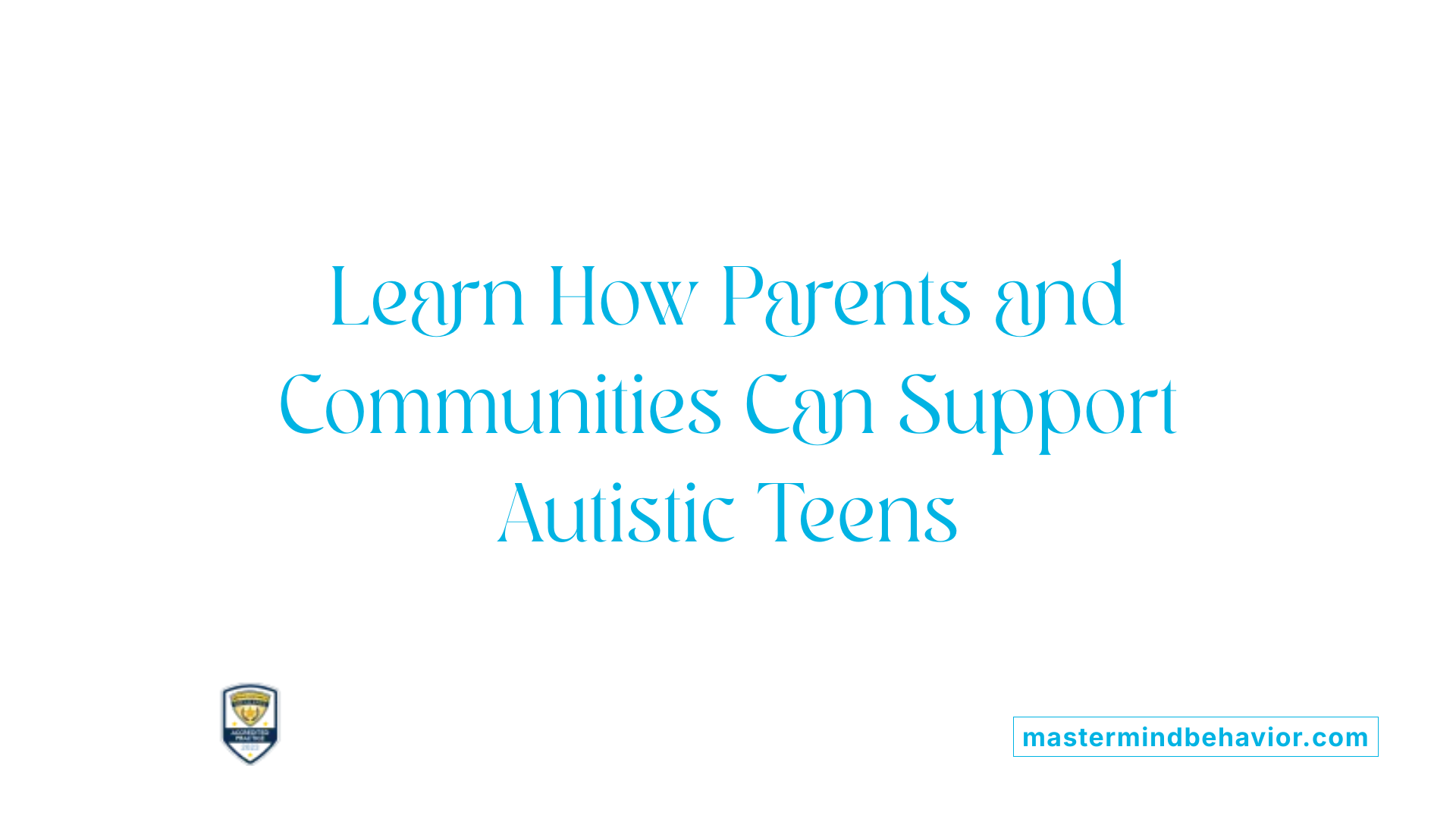
How can parents and caregivers support and facilitate skill development in autistic adolescents?
Parents and caregivers play a pivotal role in nurturing independence among autistic adolescents. They can create consistent, natural environments that promote learning across daily activities such as self-care, household chores, and community navigation. These environments help adolescents apply skills practically, building confidence and competence.
Visual supports like checklists, schedules, and task analysis are excellent tools that help clarify routines and expectations. For example, visual checklists for morning routines or cooking steps enable adolescents to follow through independently. Incorporating these supports into daily routines ensures skill acquisition is tangible and manageable.
Teaching should always be personalized. Starting from the adolescent's current abilities, caregivers can gradually introduce new skills through reinforcement, modeling, and hands-on practice. Practicing skills in real-world settings — like grocery shopping trips, laundromats, or community parks — provides contextual learning that transfers well into everyday life.
Encouraging adolescents to participate in planning and decision-making activities fosters self-determination. For instance, allowing them to choose what to cook or select clothing supports autonomy and confidence.
Community involvement enhances this learning process. Attending social groups, participating in community outings, or engaging with peer-supported programs develop social skills and safety awareness.
Collaboration with educational and therapy providers ensures consistency in skill development. Using intervention tools, such as specialized checklists or guides, strengthens the connection between home and therapy goals.
Ultimately, by combining these approaches, caregivers can support the development of essential life skills, aiding adolescents in achieving greater independence and a successful transition into adulthood.
Practical Strategies for Developing Life Skills
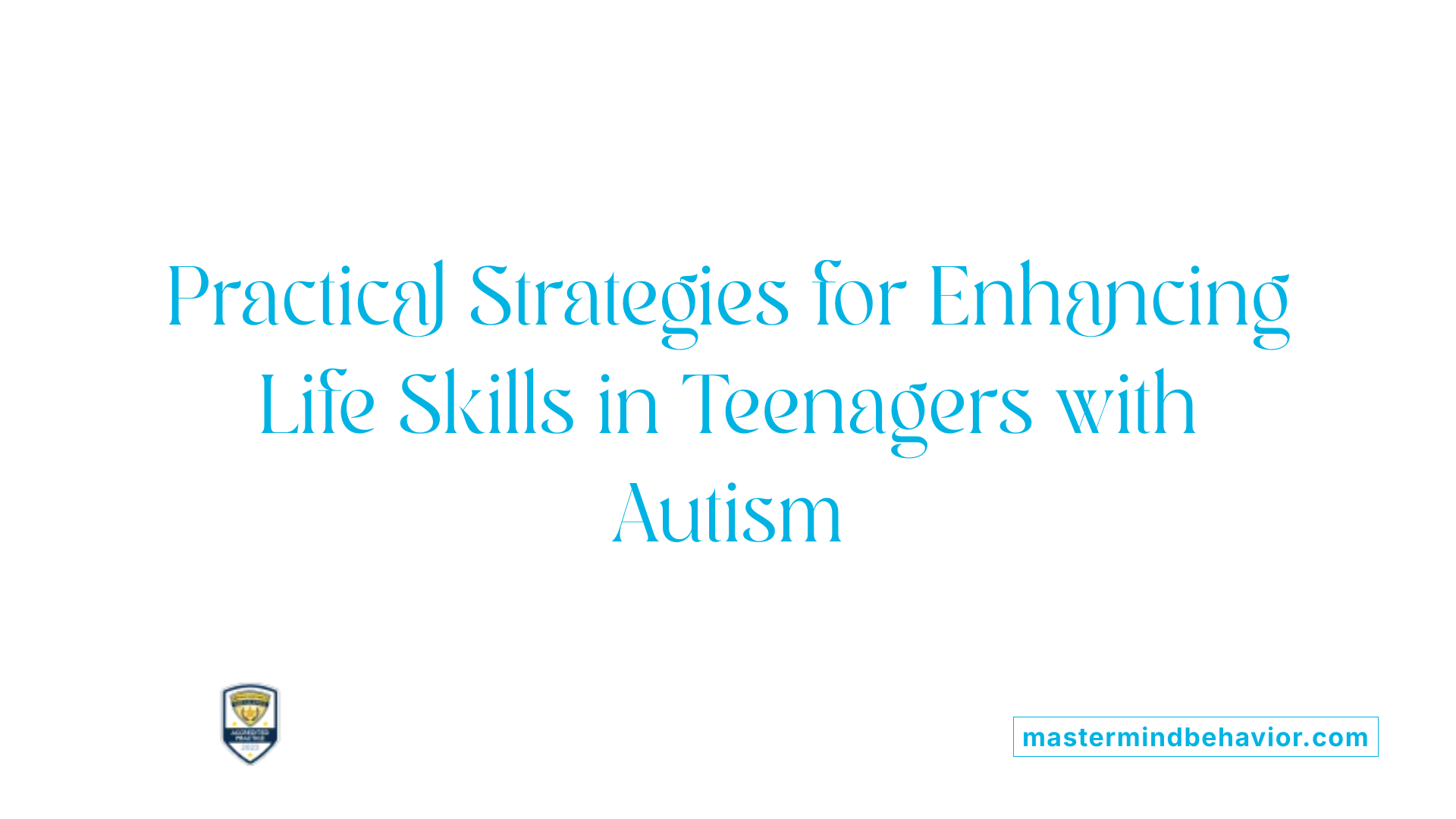
What strategies for developing life skills in teenagers with autism?
Developing life skills in teenagers with autism requires a tailored approach that considers each individual's interests, strengths, and specific needs. One of the most effective methods involves breaking down complex tasks into small, manageable steps using task analysis. This approach helps teens understand each component of a skill, such as brushing teeth or preparing a simple meal.
Chaining techniques, where each step leads logically to the next, combined with modeling—demonstrating desired behaviors—are powerful in teaching routines like dressing or grocery shopping. Visual supports such as charts, checklists, and pictorial schedules reinforce understanding and remind teens of the steps involved.
Involving parents, caregivers, and peers in social skills training provides real-life practice opportunities. Role-playing scenarios and social stories prepare teens for interactions in various settings, promoting confidence and social competence.
To motivate and retain engagement, positive reinforcement, including praise and small rewards, celebrates milestones and progress. Incorporating teens' interests, whether cooking, gaming, or specific hobbies, makes learning more enjoyable.
Utilizing real-life practice environments—such as kitchens for cooking or community centers for socialization—helps teens generalize skills beyond the training context. Consistency and patience are crucial, with adaptations made as the teen develops.
Overall, these strategies, combined with visual aids and community involvement, create a comprehensive framework that nurtures independence and confidence, setting the stage for successful transition into adult responsibilities.
Early Planning and Goal Setting for Independence
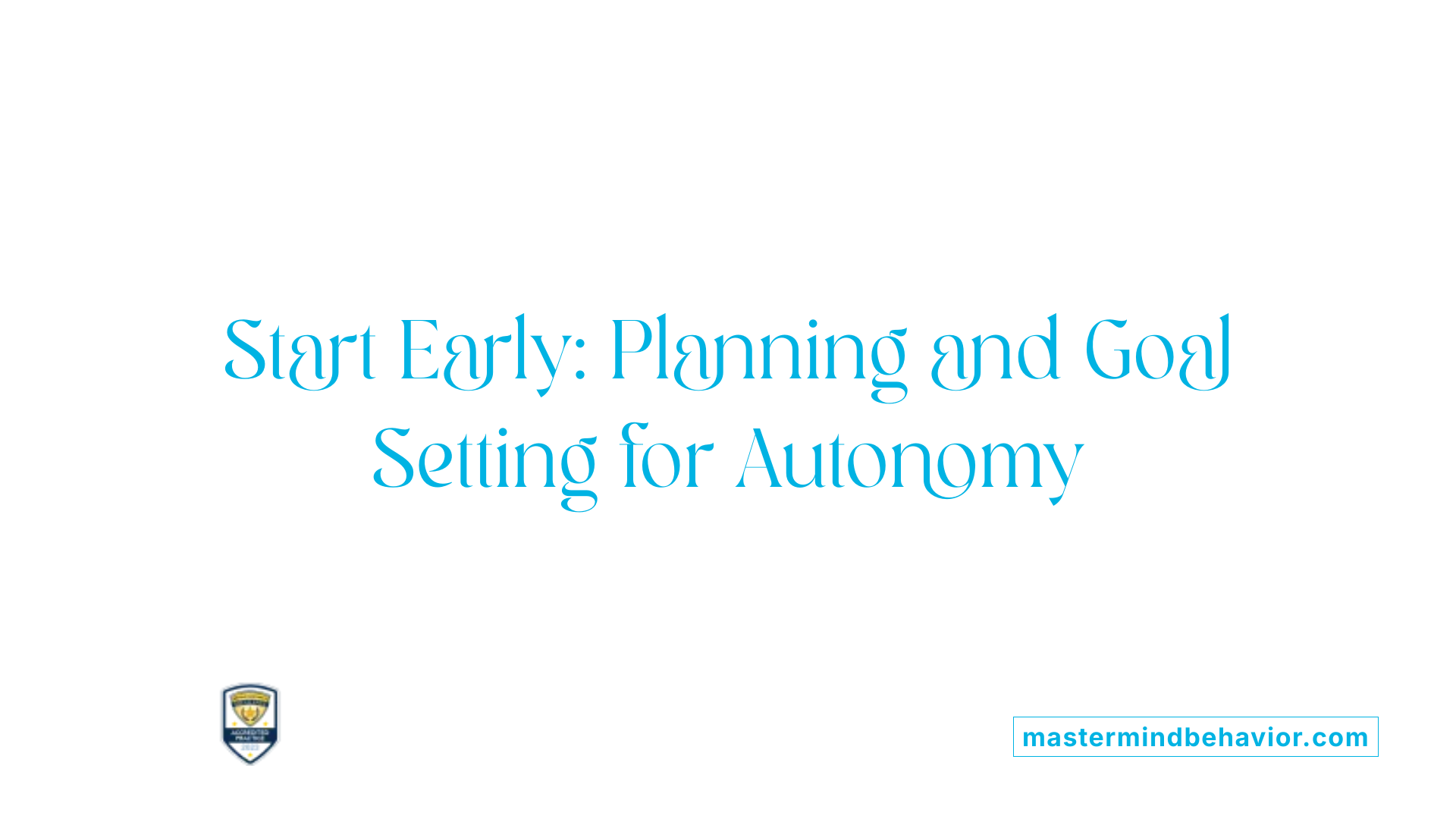
How can parents help autistic teens prepare for independence and adulthood?
Supporting teens with autism as they transition into independent living is a critical process that benefits greatly from early and strategic planning. Parents play an essential role in guiding this journey, beginning around age 12 to 14.
One of the first steps is initiating detailed transition planning within the framework of the Individualized Education Program (IEP). Working closely with educators and service providers, parents should ensure that transition goals are focused on postsecondary education, employment, and community participation. These goals should be realistic and tailored to the teen’s interests, strengths, and needs.
Developing comprehensive IEP transition plans involves regular assessments and updates to evaluate progress and adjust plans as needed. This includes exploring various support services, such as 504 plans, and utilizing community resources, social stories, and transition toolkits to develop social, safety, and self-advocacy skills.
Practicing daily routines, decision-making, and self-advocacy helps build confidence and independence. This includes teaching the teen how to manage personal care, begin to handle money, and navigate social situations.
Parents should also actively explore educational pathways—vocational training, college programs with accommodations, internships, and supported employment—to identify the best options for their teen.
Legal awareness is equally important. Understanding legal rights, decision-making options, guardianship considerations, and accommodations allows parents to prepare their teens for the responsibilities and rights they will have as adults.
To coordinate this effort, involving community providers such as occupational therapists, vocational specialists, and social workers can be very beneficial. These professionals can offer targeted training and support.
Throughout this process, ongoing communication with the teen is vital to ensure they feel supported and involved in their future plans. Regular assessment of the teen’s goals and progress helps to keep the planning personalized and meaningful.
Ultimately, early and thorough transition planning creates a solid foundation for teens with autism to achieve greater independence and a successful transition into adulthood.
Assessment Tools for Evaluating Skill Development
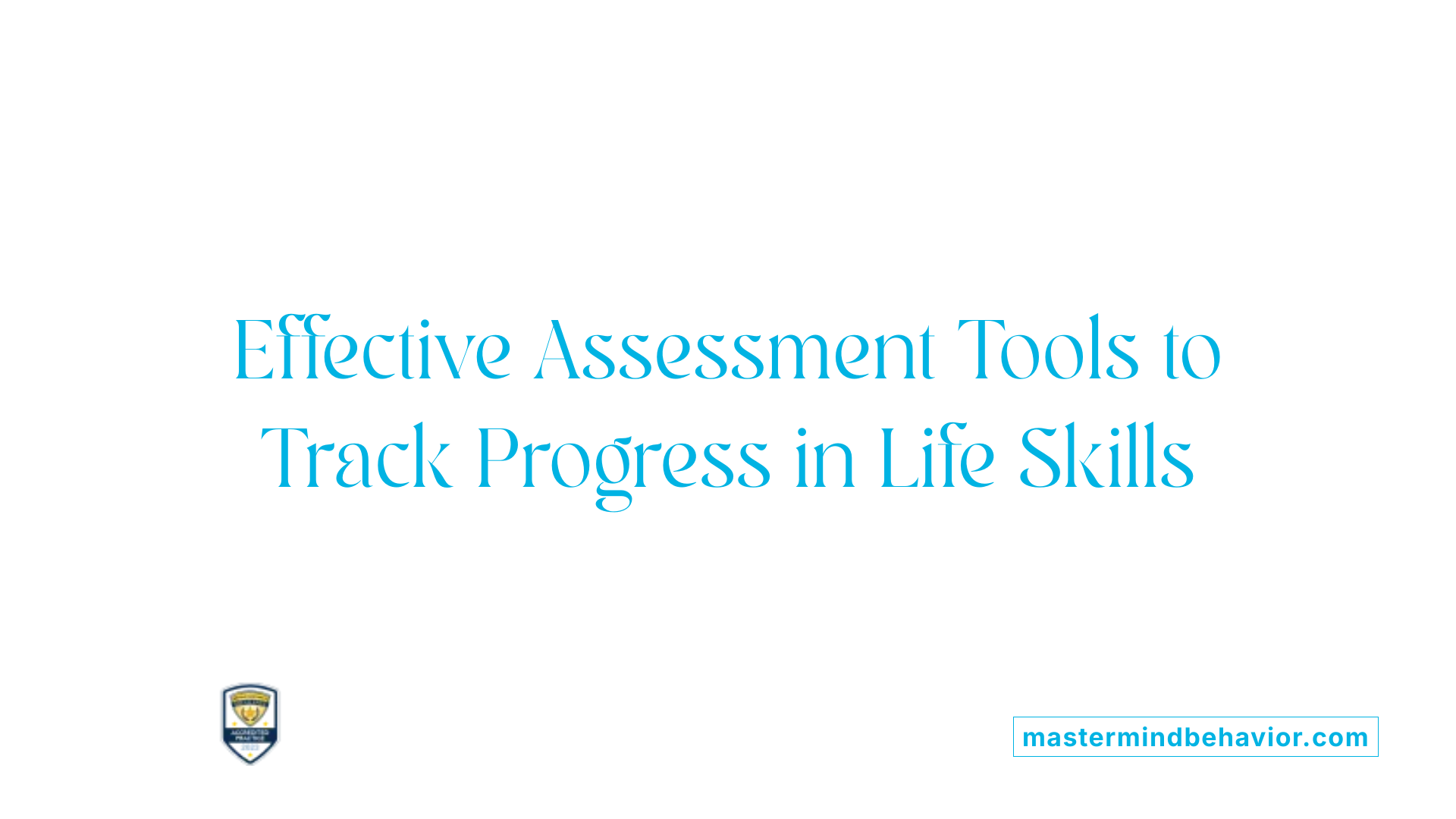
What assessment tools are used to evaluate skill development in autistic adolescents?
Evaluating the progress of autistic adolescents in developing essential life skills requires a combination of standardized tests, observational measures, and interview-based assessments. These tools help professionals and families tailor interventions, track improvements, and identify areas needing additional support.
The Community-Based Skills Assessment (CSA) is a prominent choice for assessing functional life skills in adolescents. It covers eight vital areas: employment, self-determination, health, socialization, community participation, transportation, leisure activities, and home living skills. The CSA involves direct observations and interviews, providing a realistic picture of an individual’s current competencies in everyday contexts.
In addition to the CSA, the Vineland Adaptive Behavior Scales (Vineland-II and Vineland-3) are widely used to measure adaptive personal and social skills. These scales are suitable for various age groups, offering insights into communication, daily living skills, socialization, and motor skills. They are helpful in setting realistic goals and monitoring developmental progress.
The Adaptive Behavior Assessment System (ABAS-3) presents a comprehensive overview of adaptive skills across the lifespan. It gathers information from parents, teachers, or caregivers to evaluate strengths and challenges in personal, social, and practical skills.
For language and communication evaluation, tools like the Vineland scales are complemented by the ABLLS-R (Assessment of Basic Language and Learning Skills—Revised) and the VB-MAPP (Verbal Behavior Milestones Assessment and Placement Program). The ABLLS-R focuses on foundational language skills critical for meaningful communication, while the VB-MAPP assesses verbal behavior and social skills, guiding targeted interventions.
Supporting practical daily living skills, the Assessment of Functional Living Skills (AFLS) provides a criterion-referenced framework. It evaluates skills such as personal hygiene, safety, money management, and household chores, enabling customized development plans.
| Assessment Tool | Purpose | Type of Data | Ideal For | |
|---|---|---|---|---|
| CSA | Functional life skills assessment | Observation and interview | Adolescents | Life skills, community participation |
| Vineland-3 | Personal and social skills evaluation | Standardized rating scales | All age groups | Adaptive behaviors, socialization |
| ABAS-3 | Lifespan adaptive skills assessment | Questionnaire | Children to adults | Rehabilitation planning |
| ABLLS-R | Language and early skills | Criterion-referenced | Early learners, school-age | Language development |
| VB-MAPP | Verbal behavior milestones | Assessment and placement | School-age | Communication, social skills |
| AFLS | Daily living skills | Criterion-referenced | All ages | Independent living skills |
More Resources
For those interested in expanding their understanding or finding additional assessment resources, searching for terms like "assessment tools for autism life skills," "adaptive behavior scales," "CSA," "Vineland," "ABAS," "VB-MAPP," and "AFLS" will yield beneficial results. These tools are often used in combination to provide a comprehensive view of an individual’s capabilities and guide effective intervention plans.
Careful assessment is the foundation for successful skill development in autistic adolescents. Utilizing a blend of these tools ensures a tailored approach that promotes independence, confidence, and overall quality of life.
Resources, Programs, and Curriculum Supports
What resources and programs support life skills training and independence for autistic teens?
Supporting autistic teens in developing essential life skills involves a range of specialized curricula, community programs, and online resources designed to foster independence and confidence. Many organizations recognize the importance of early, structured, and practical teaching strategies.
One foundational approach includes implementing tailored curricula such as the Stepped Transition in Education Program for Students with ASD (STEPS). This curriculum focuses on self-determination, self-regulation, and transition readiness, with versions for secondary students and college attendees. Results indicate it effectively enhances transition skills and college adjustment, providing a solid framework for students and their families.
Community-based programs like CIP’s Full-Year Transition Program are also instrumental. These programs offer hands-on learning experiences in supported apartments, emphasizing real-world skills such as budgeting, household management, social planning, and recreation. Students participate in activities like cooking, cleaning, and community outings, which serve to build independence and confidence in a safe environment.
Online resources and checklists are widely used to complement hands-on learning. Tools such as the Assessment of Functional Living Skills (AFLS), visual schedules, and detailed checklists help assess current abilities and plan targeted interventions. Visual aids like charts, checklists, and video modeling are effective for teaching routines, task sequencing, and social skills.
Hands-on training programs like CIP’s Life Skills classes aim to provide practical, experiential learning. These programs often include role-playing, community outings, vocational training, and support for daily living skills such as grooming, cooking, and using transportation.
In addition, structured curricula like the Step Up Life Skills program by Novita support teenagers with disabilities through skill development in independence, social skills, and confidence-building activities. Such initiatives demonstrate positive outcomes such as increased community engagement and improved independent living abilities.
Educational institutions and transition programs are increasingly incorporating evidence-based curricula, such as the STEPS curriculum, which trains students in self-determination, advocacy, and emotional resilience—vital areas for successful adulthood. Curricula are often paired with assessments, like the Community-Based Skills Assessment (CSA), to track progress and tailor learning plans.
Finally, community involvement and vocational programs like those offered at Connections High School & Vocational Center and the NEILS Program support independent living and employment readiness through targeted skills training, social activities, and individualized support plans. These programs incorporate real-world experiences such as internships, job shadowing, and social clubs.
In summary, a comprehensive approach combining specialized curricula, community-based activities, online resources, and experiential learning opportunities effectively equips autistic teens with critical life skills. This multifaceted support system promotes independence, self-confidence, and successful transition into adulthood.
Teaching Social, Emotional, and Safety Skills for Independent Living
What techniques are effective in teaching social, emotional, and safety skills necessary for independent living in autistic teens?
Teaching social, emotional, and safety skills to autistic teens requires a thoughtful combination of methods tailored to each individual’s needs. Visual supports such as social stories, visual schedules, and checklists play an essential role in helping teens understand expectations, routines, and appropriate interactions. These tools make abstract concepts more concrete, aiding comprehension and independence.
Role-playing and modeling are practical techniques that allow teens to practice real-world scenarios in a safe environment. For example, by simulating greetings, refusals, or how to ask for help, teens can develop effective communication skills and confidence. These interactive methods also help reinforce social cues and proper responses.
Behavioral techniques like Behavioral Skills Training (BST) are especially effective for teaching safety skills. BST involves providing clear instructions, demonstrating desired behaviors, rehearsing the skill, and then giving feedback. This structured approach ensures mastery of critical skills such as stranger safety, emergency procedures, and navigating unfamiliar environments.
Practicing these skills in natural settings—like community centers, grocery stores, or parks—is vital to promote generalization and independence. Learning in real-life environments helps teens adapt their behaviors to different contexts and reduces reliance on prompts.
Collaboration with families and professionals enhances the training process. Sharing progress, strategies, and routines ensures consistency across settings and reinforces learning. Engaged caregivers and service providers can provide ongoing support and real-time feedback, which are crucial for skill retention and confidence.
In summary, combining visual supports, role-playing, behavioral training, and community-based practice creates a comprehensive framework for teaching essential social, emotional, and safety skills, empowering autistic teens to navigate their adult lives more safely and independently.
| Technique | Description | Effective Use Cases |
|---|---|---|
| Social stories | Visual narratives explaining social situations | Teaching new social routines or safety protocols |
| Visual schedules | Timelines and checklists to support routines | Managing daily activities and safety procedures |
| Role-playing | Simulating social interactions and emergencies | Practice conversations, safety responses, and greetings |
| Behavioral Skills Training | Instruction, demonstration, rehearsal, feedback | Learning safety behaviors, stranger safety, emergency responses |
| Natural environment practice | Real-world setting practice | Grocery shopping, navigating public transport |
| Collaboration with caregivers | Consistency and reinforcement | Ensuring skills are maintained across settings |
Focusing on these effective techniques, with ongoing community and family support, significantly improves autistic teens’ readiness for independent living and safe community participation.
Research and Evidence-Based Practices in Life Skills Education
What are evidence-based practices and research findings related to life skills education for autistic teens?
For educators and therapists working with autistic adolescents, understanding the most effective methods for teaching life skills is critical. Evidence-based practices (EBPs) are interventions and strategies validated by rigorous scientific research. When it comes to developing independence in this group, several EBPs stand out.
One widely supported approach is applied behavior analysis (ABA). This method uses systematic teaching techniques, reinforcement, and data collection to establish and improve specific skills. For example, ABA can help teach routines, safety awareness, and daily living tasks, ensuring behaviors are learned effectively and maintained over time.
Social stories, another well-validated tool, help prepare teens for social and community interactions. These short, descriptive narratives explain social cues, expectations, and appropriate responses, making complex social concepts more accessible.
Visual supports, including visual schedules, checklists, and cues, enhance comprehension and retention. These tools help adolescents understand routines, sequence steps in activities like cooking or shopping, and promote independence.
Natural environment teaching involves embedding learning opportunities into everyday settings—such as kitchens, laundromats, or community centers. This contextualized approach promotes generalization, meaning skills learned in therapy are more likely to be used confidently in real-world situations.
Effective programs also incorporate individualized planning that considers each teen’s strengths, preferences, and specific needs. This tailored approach ensures that interventions are relevant and motivating, leading to better engagement and outcomes.
Holistic strategies combine these evidence-based methods with comprehensive components—such as money management, transportation safety, vocational training, and self-advocacy—to prepare adolescents for independent living.
Team collaboration is vital. Families, educators, clinicians, and employment specialists work together to design and implement interventions, monitor progress, and adjust plans as needed. Continuous data collection helps assess the efficacy of strategies and guide decision-making.
Research consistently supports that integrating scientifically supported techniques within a personalized and holistic framework results in meaningful improvements in life skills development. These advancements increase not only independence but also confidence and happiness for autistic teens as they navigate adulthood.
| Intervention Method | Description | Evidence Level | Additional Notes |
|---|---|---|---|
| Applied Behavior Analysis (ABA) | Systematic reinforcement and skill acquisition | Strong, extensively validated | Useful for routines, safety, and daily living skills |
| Social Stories | Narrative-based social understanding | Validated, widely used | Effective for social cues and community skills |
| Visual Supports | Use of charts, checklists, and cues | Strong evidence | Enhances memory and task sequencing |
| Natural Environment Teaching | Learning in real-world settings | Supported by research | Promotes skill generalization |
In conclusion, applying these practices within a structured, customized plan can significantly promote independence and improve quality of life for autistic adolescents. Ongoing research continues to refine these methods, ensuring that approaches remain effective, relevant, and person-centered.
Fostering Independence: A Collaborative and Personalized Approach
Preparing teens with autism for adult independence requires a proactive, collaborative effort rooted in early planning and personalized instruction. Utilizing a variety of assessment tools to set realistic goals, implementing evidence-based teaching strategies, and leveraging community resources are crucial steps. Families, educators, and service providers must work together—embracing naturalistic, practical experiences and reinforcing skills in real-world settings—to nurture confidence, resilience, and self-advocacy. Supporting the development of social, emotional, and functional skills ensures a smoother transition into adulthood, empowering autistic youth to reach their full potential.
References
- Life skills for autism | Autism Speaks
- Preparing for Adulthood: Essential Skills for Individuals with Autism
- Teenage Life Skills Checklist | Transitions
- Framework for developing self-actualization skills in young adults ...
- Support your autistic teen to develop life skills and prepare them for ...
- Improving Transition to Adulthood for Students with Autism
- Preparing an Autistic Child for Adulthood: Getting Started Early
- How Teenagers with Autism Can Prepare for Adulthood










